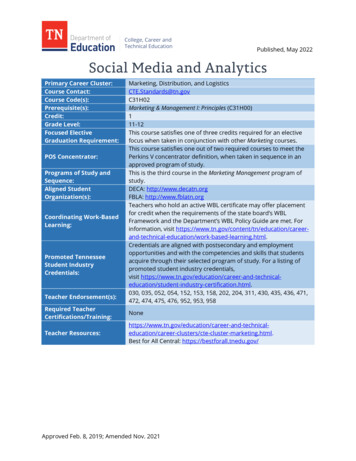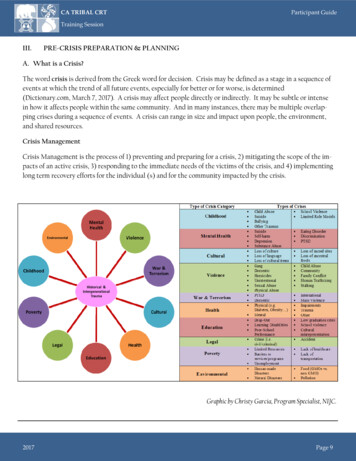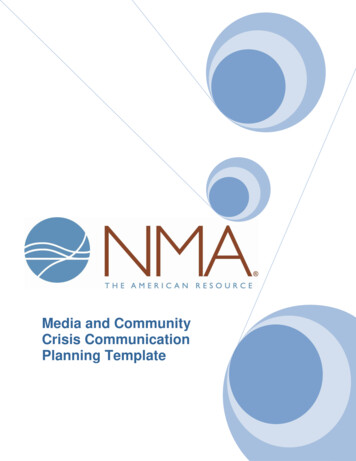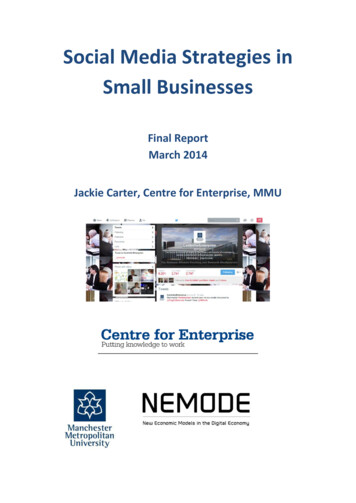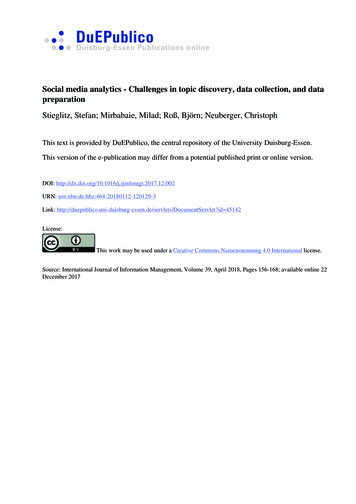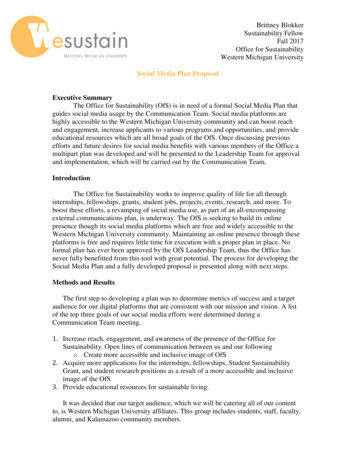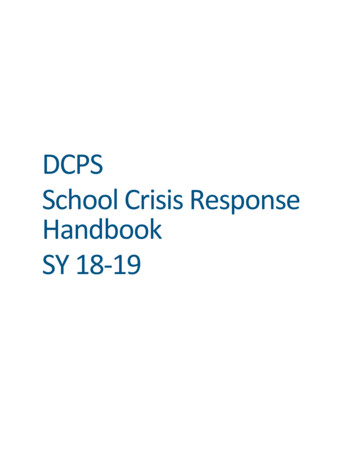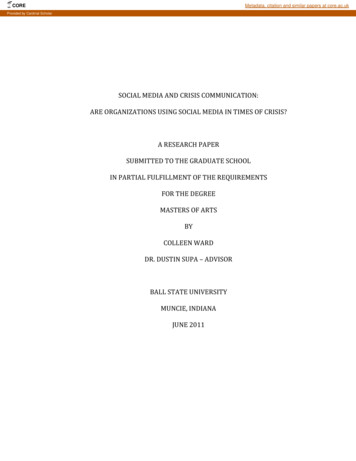
Transcription
COREMetadata, citation and similar papers at core.ac.ukProvided by Cardinal ScholarSOCIAL MEDIA AND CRISIS COMMUNICATION:ARE ORGANIZATIONS USING SOCIAL MEDIA IN TIMES OF CRISIS?A RESEARCH PAPERSUBMITTED TO THE GRADUATE SCHOOLIN PARTIAL FULFILLMENT OF THE REQUIREMENTSFOR THE DEGREEMASTERS OF ARTSBYCOLLEEN WARDDR. DUSTIN SUPA – ADVISORBALL STATE UNIVERSITYMUNCIE, INDIANAJUNE 2011
TABLE OF CONTENTSChapter I - ----------------------------------- 1Chapter II - Literature --------------------- 4Chapter III - ---------------------------------14Chapter IV - ---------------------------------- 16Chapter V - ---------------------------------- 21Chapter VI - -------------------------------- 25
CHAPTER IINTRODUCTIONThere is much research as to what exactly creates a crisis, how to plan for acrisis, how to manage a crisis and the best responses to a crisis. Scholars havedefined a crisis in many ways, but a widely accepted definition is “a majoroccurrence with a potentially negative outcome affecting an organization, companyor industry as well as its publics, products or good name” (Fern-Banks, 2007, p.1).Crisis communication as a field of study is still growing while scholars are stilldeveloping best practices and theories in order to better understand crisiscommunication and crisis response.Crises have the potential to bring down an organization as in the case ofEnron, damage the organizational reputation as in the Exxon-Valdez crisis or theycan even improve the reputation of an organization if dealt with correctly as inTylenol’s case. How an organization plans for and responds to a crisis directlycorrelates to how or if they will survive the crisis. Crisis managers must put togethera team, and then, with that team, develop a plan for each potential crisis that couldimpact the organization. By using these tools, crisis managers can develop a roadmap of how a crisis can be dealt with in order to better prepare the organization.Crisis communication mainly falls under the job of public relationspractitioners in today’s organizations. Because of public relations practitioners’
2expertise in the field of communicating with stakeholders, crisis communicationsfalls under their duties. Practitioners are beginning to look at new ways ofcommunicating during a crisis, including using social media.Social media and Internet technologies are new to scholarly research. Socialmedia is a form of user-generated media that allows interactivity between users.Social media users can create and upload their own content such as photos, stories,and videos to web sites like Facebook, Twitter, blogs and YouTube. Social mediaengages publics in a conversation online. Corporations, while they are widely usingother Internet technologies in their day-to-day public relations practices, are stilllearning to incorporate social media in to crisis communication plans.Social media can have both positive and negative effects on an organization’simage. Users of social media often use this communication tool to discuss theirexperiences with a company and especially their customer service experiences. If auser is upset, they can often tell their story online with blogs or Twitter. This canbring much unwanted negative attention to an organization if the person has a largefollowing. On the other hand, social media can allow organizations to participate intwo-way communication with their stakeholders. Companies can use social media totake part in the conversations on the Internet and can quickly respond to any issuesthat may arise. Social media can allow companies to have stronger relationshipswith their stakeholders through constant communication.The role social media can play in crisis communication has barely beenstudied. What role and what impact social media can have on a crisis is still
3uncertain. In today’s technology driven Internet world, crises can arise at anymoment on the Internet. For organizations to be prepared, they must begin toincorporate social media in to their crisis plans. Not only can social media helporganizations when crises arise on the Internet, but they can also help organizationscontrol the situation and respond to more traditional crises. It is important to lookat how organizations are beginning to incorporate these new technologies in totheir crisis plans and how it is affecting them.Social media can be a powerful tool in crisis communication if organizationscan learn to incorporate it and learn to use it successfully. This study will help todefine if and how organizations are using social media in their crisis communicationplans.
CHAPTER IILITERATURE REVIEWCrisis CommunicationThere are many ways to define a crisis in an organizational setting. FernBanks (2007) describes it as “a major occurrence with a potentially negativeoutcome affecting an organization, company or industry as well as its publics,products or good name” (pg. 1). Crises can also be defined as a sudden anduncontrollable event that can threaten the life of the organization and in some casesthe lives of people. (Thelwall & Stuart 2007).Crises are often unpredictable and can have the potential to harm anorganization and its stakeholders (Massey & Larsen 2006). A crisis is a lowprobability, high impact event that can put the viability of the organization in dangerand it often requires decisions to be made swiftly (Pearson & Clair 1998). Crisesinterrupt normal business and often threaten an organization’s existence (FernBanks 1997). Practitioners must realize that crises pose a threat to an organizationand its values and that they have a very short time in when they should respond tothe crisis.Crises and the communication involved with a crisis often falls under the jobof the public relations staff of an organization. Public relations practitioners are
5responsible for both the internal and external communication during the crisis(Burnett 1998). There are many in the field who believe that the practice of publicrelations is about building and maintaining relationships with the organization’spublics (Broom, Casey, & Ritchey 1997). So who better to communicate with thepublics during a crisis than the public relations practitioners who do so on a dailybasis. One of the jobs of a public relations staff is to produce the strategic responsesto crises (Burnett 1998). These planned responses allow organizations to releaseinformation quickly if a crisis were to occur (Marra 1998). For public relationsmanagers, this is to help decrease uncertainty in times of crisis (Burnett 1998).Ultimately the goal of crisis managers is to prepare the best strategies for any givencrisis (Cho & Grower 2006).Fishman (1999) suggests five common characteristics of a crisiscommunication situation: “First, an unpredictable event occurs. Second, importantvalues for an individual or institution must be threatened in order for a crisiscommunication situation to exist. Third, the intention of an actor or an organizationplays a minor, if negligible role in analyzing a crisis communication situation.Fourth, crisis communication occurrence represents a time-sensitive situation. Fifth,a crisis communication situation involves a dynamic or multi-dimensional set ofrelationships within a rapidly changing environment” (Fishman 1999, 347-348).Crises generally have three stages. Pre-crisis allows warning signs to gounchecked. The actual crisis occurs and the organization rushes to make sense ofthe issue and attempts to limit the damage to the organization and its stakeholders.
6Post- Crisis is when the crisis has passed and business returns to normalcy (Smudde2001).Fern-Banks (2007) breaks a crisis down further in to five stages of a crisis.These stages consist of detection, prevention, containment, recovery and learning.Detection refers to watching for warning signs of a crisis. Prevention is the practiceof ongoing public relations programs to either prevent crises from happening orlessen the blow of a crisis, this includes the crisis communication plan. Containmentdeals with limiting the duration of the crisis or to keep the crisis from spreading.Recovery includes helping the organization return to business as usual andrestoring normalcy. Lastly, learning is important because it allows the organizationto look at what was lost from the crisis, what was gained and how the organizationperformed in the crisis in order to be better prepared for the next crisis, becausethere will always be another crisis.The public’s perception of an organization can depend on how well thatorganization was prepared for a crisis when it hit. If an organization is unpreparedwhen a crisis occurs, there may be two levels of the crisis, the actual incident orevent that occurred and then when the organization is unprepared, a second crisisoccurs as they scramble to respond to the original crisis (Murray & Shohen 1992).Organizations who can identify possible crises are more willing to plan for thosecrises in the future (Penrose 2000). In order for crisis management to be effective itmust be proactive (Perry, Taylor & Doerfel 2003). Crisis management is not only anemergency preparedness plan, but it involves thinking and planning for a wide
7range of crises and their impact on organization’s and their stakeholders (Mitroff,Diamond, & Alspaslan 2006).It is critical to the success and survival of an organization that there is a crisiscommunications plan in place (Guth 1995). Every organization, no matter the sizeor the industry should have a crisis management plant (Fink 1986). Planning allowsthe organization to develop a crisis team as well as plans to put in to action when acrisis does occur (Massey & Larson 2006). The crisis plan is important because itallows organizations to recognize potential problems that could arise and threatenthe organization and give the organization and opportunity to plan for thesescenarios (Penrose 2000).When an organization has the opportunity to predict and plan for crises they aremore likely to capitalize on that than an organization with no plan (Fink 1986).When an organization identifies potential crises, they are more likely to plan forthose crises (Penrose 2000). Decisions and plans that a crisis team makes today willdirectly influence the organization’s ability to survive a crisis tomorrow (Umansky1993). It has often been found that crises that were managed poorly had a lack ofcrisis plan (Marra 1998). “(A crisis plan) is a manual, a blueprint, a road map out ofdangerous woods. It covers everything from A to Z on how to manage types ofcrises” (Fink 1986, 56).Following preparation, responding to and communicating during the crisisare the next important steps to good crisis communication (Penrose 2000). While
8communicating during the crisis, the most important thing to communicate is thatthe organization is protecting its stakeholders from any further harm be it physical,emotional or any other form of harm, over protecting the organization’s reputation(Coombs 2007). When a crisis hits, there are certain types of information thatshould be communicated to the stakeholders as soon as possible. These include thecrisis basics, protection and correction (Coombs 2006). The crisis basics are thebasics of what has happened. The protection is what the company is doing to protectthe stakeholders, and the correction is what the organization is going to do tocorrect the problem(s).“Research has shown that crisis response strategies – what an organizationsays and does after a crisis – can affect a variety of important crisis communicationoutcomes including the organizational reputation, anger, negative word of mouthand account acceptance” (Coombs & Holladay 2009, 2). These planned responseshelp to reduce the amount of time it takes for an organization to respond during acrisis (Coombs 2000; Benoit 1997). It is important for crisis mangers to rememberto keep the responses consistent throughout the duration of the crisis, asconsistency is more effective (Massey 2001).Social Media and Crisis CommunicationSocial media and new Internet technology has the ability to play a large rolein public relations. Public relations practitioners must understand the new role theInternet can play to gather information both for their publics and for themselves(Christ 2005). The introduction of blogs and other Internet technologies has
9definitely changed the way public relations is practiced (PRSA 2007). In 2009, 73%of public relations practitioners surveyed said that the emergence of blogs and otherforms of social media have changed the way they communicate with their clients(Wright and Hinson, An Updated look at the impact of social media on publicrelations practice. 2009). Social media has the potential to one day contribute toagenda building for public relations practitioners so they must learn to adopt it intotheir practices (Lariscy, et al. 2009).Social media has quickly become one of the most used Internet technologies.Social media creates a media of the masses (Baker and Green 2005). Social media isbecoming more and more popular as communications from organizations (Wrightand Hinson, Examining how public relations practitioners actually are using socialmedia 2009). Social media allows people to create information on the web with thepurpose of assisting in communication (Wright and Hinson, Examining how publicrelations practitioners actually are using social media 2009). Social media allowspublic relations practitioners to reach out and communicate with their publics andstrengthen their relationships (Eyrich, Padman & Sweester 2008). Social media canhelp practitioners control their message and reach unsuspecting prospects for theirmessages (Marken 2007). “Social media have been classified into these categories:Internet forums, weblogs, social blogs, wikis, podcasts, pictures and video” Wright &Hinson, Examining how public relations practitioners actually are using social media2009, 11).
10From a public relations perspective, blogs and other forms of socialnetworking are excellent ways to segment the public as groups of individuals whoread the same blog or visit the same social networking site as those who sharecommon interests (Kent 2008). Social media also provides the opportunity forcustomers to interact with each other and fill information needs this way (GrensingPophal 2009). Humans have a natural need for interpersonal interaction and theInternet provides this (Phillips 2008). This interaction has resulted in aparticipatory culture where ordinary citizens can have their voices be heard by thegeneral public and large organizations, if they are listening (van Dijck 2009).Because of these reasons it is time organizations and public relations practitionersto pay attention to the online conversations taking part without them and learnways to get involved with their online publics (B. Murray 2007).The Internet has become a place for organizations to monitor issues relevantto them. In a study done by the Pew Research Center, they found that for the firsttime in 2008, more people were receiving their news from online sources ratherthan from traditional mass media (Wright and Hinson, An Updated look at theimpact of social media on public relations practice. 2009). These emerging issuescan become prominent on the Internet (Heath 1998). Internet allows organizationsto monitor issues that could develop into larger problems later on (Heath 1998).Many Public relations practitioners use the Internet for issues management becauseit allows them to reach diverse publics (Porter & Sallot 2003). By using the Internet
11for issue management, practitioners can bypass traditional media and monitor whattheir publics are actually saying and they have the ability to respond immediately tothe issues (Porter & Sallot 2003).“Social media impacts crisis communication in two distinct ways. First, theconversation can affect your organization’s perception during an event whether youare involved in the conversation or not. Second social media outlets and formatsprovide new opportunities to engage stakeholders and the media” (Baron & Philbin2009, 12).Today, many people still learn about crises through traditional media butmore and more are learning about them through online social media (Coombs2007). The new technologies, including social media, can influence whatinformation is reported, how it is reported, who reports it and in what format it isreported (Thelwall & Stuart 2007). It can also change how fast a crisis is reportedand dealt with. If a company that experiences a crisis can engage stakeholders afterthe crisis to discuss the issue with them, the organization can learn from itsmistakes (Martin 2008).With the use of the Internet, news about a crisis can spread quickly and without any boundaries (Bucher 2002). Social media can give very few individuals thepower to create a crisis quickly and sometimes unexpectedly for a largeorganization (Learmonth & Parekh 2008). It can also be very difficult to remove theexistence of negative publicity from the Internet, even when a crisis has ended(Gonzalez-Herrero & Smith 2008). The Internet and social media can also aggravate
12crises as it has the potential to escalate crises (Dinardo 2001). “Hence, the internetplays a double-edged role in crisis communication. On the one hand, it increases therisk of information thanks to the loss of traditional journalistic controls over theinformation market. On the other hand, the internet extends the possibilities ofgetting information in a manner that has not been available up to now” (Bucher2002, 5).Social media and the Internet allows for strategic communication in order toinform and seek opinions of stakeholders and can be used as a crisis communicationand management tool (Taylor & Perry 2005). These new technologies provide bothlarge and small organizations and businesses the opportunity for a direct link totheir publics (Perry, Taylor & Doerfel 2003). Public relations practitioners canexperiment with the use of social media in crisis plans when they have their nextcrisis drill (Baron & Philibin 2009). Crisis managers not only need to develop plansfor crises that arise on the Internet but they need to begin developing plans forcrises that include Internet communication and social media (Gonzalez-Herrero &Smith 2008).Crisis communication plans must include monitoring and communication onsocial media sites in the pre-crisis phase (Baron & Philibin 2009). Just as companiesmonitor phone calls and letters to the organization, they must also begin to monitorthe web including social media and blogs in order to find out what publics aresaying about them (Fern-Banks 2007; Blackshaw & Iyer 2003). If an organizationhas been monitoring and they find an issue on the Internet, answering or
13responding to the issue right then can help to contain an issue before it creates alarger crisis (Christ 2005). Social media allows for feedback between organizationsand their stakeholders that can help avoid crises (Perry, Taylor and Doerfel 2003).Many organizations use social media sites such as blogs as part of their crisiscommunication plans, but they don’t use it to replace the entire plan (Fern-banks2007). Twitter can also be used to monitor and respond to issues before theybecome full- blown crises (Stewart 2008).When organizations use new technologies such as the Internet and socialmedia in their crisis management plans, it gives the perception that they are tryingto supply timely information to as many publics as possible, leading to a morepositive image of the organizations during and after the crisis occurs (Sweester &Metzgar 2007). The use of social media during a crisis can allow organizations toreach more publics as well as increase understanding, change perceptions and savetime and money (Perry, Taylor and Doerfel 2003).RESEARCH QUESTIONSR1: Are organizations incorporating social media in to their crisis communicationplans?R1.1 How are organizations using social media in their crisis communicationplansR1.2 What types of social media are organizations using for crisis responses?R1.3: What effects have organizations using social media in times of crisisexperienced?
CHAPTER IIIMETHODOLOGYOnline surveys were used to collect quantifiable data from public relationspractitioners in various industries from throughout the state of Indiana. An onlinesurvey was chosen for several reasons. Online surveys are inexpensive and canreach a wide population fast as compared to other survey methods such as mailsurveys, which can be expensive with postage and somewhat slow with responses.They offer fast results with no interviewer bias when compared to in person surveysor telephone surveys. The anonymity that online surveys provide is also beneficialto this research study because the topic could be considered sensitive when dealingwith organizations in crisis. Also, because this study involves Internet technologiessuch as social media, an online survey was appropriate to gauge an organization’suse of Internet technologies.The population for the survey was public relations practitioners from thestate of Indiana. The researcher visited agency, healthcare, corporations, non-profitsand other various business’ websites in order to compile a list of 510 publicrelations, communications, and investor relations contact information for thissurvey. The website surveymonkey.com was used to host the survey. Each
15practitioner was emailed a link to the survey two times with a response rate of 105or just over 20 percent.The survey included both multiple- choice questions and Likert-stylequestions. Each Likert style question directly related to answering one part of theresearch question. The multiple-choice questions gave background information onthe types of organizations and public relations practitioners who responded to thesurvey.Following the collection of the survey results, responses were entered intoSPSS in order to find the frequency of each answer and the percentage ofrespondents. This information will help to see how the average organization usessocial media in their crisis communication plan and help to answer the originalresearch questions.
CHAPTER IVRESULTSThe following results are based on the 105 responses from public relationsprofessionals in the state of Indiana. Not all 105 of those surveyed answered all ofthe questions as they had the option to opt out of the survey at any time. Of thosethat answered what type of organization they worked for, 18.1 percent were froman agency, 19 percent worked at a nonprofit, 10.5 percent worked for a corporation,10.5 percent were from a government agency, and 21.9 percent worked ineducation. The positions those surveyed held ranged from CEO and owner toaccount assistant.Of the 105 responses, 59 percent responded that they communicate withtheir stakeholders through social media on a daily basis. In a similar question, whenasked if they used social media on a regular basis to communicate withstakeholders, 75 percent responded with yes. They primarily use Facebook andTwitter with 47.6 and 52.4 percent respectively reporting they use those forms ofsocial media on a daily basis.YouTube is used less often with 31.4 respondents reporting they use itmonthly and 16.2 percent reporting they never use it to communicate withstakeholders. Corporate blogs were the least used form of social media, with 41percent reporting they never use it and only 20 percent saying they use it weekly.
17When asked if their organization had a crisis management plan, 70.5 percentresponded that they did. When asked about the different types of social mediaincluded in their crisis plan, majority of the responses were no with 45.7 percentreporting Twitter was not included in their plan, 44.8 did not include Facebook, 59percent did not include blogs and 69.5 percent did not include YouTube. Of thoseforms of social media, again Twitter and Facebook were used most often in crisisplans with 34.3 and 35.2 percent respectively saying they included them in theircrisis plans. The majority or 75.2 percent of those who responded said they usedsocial media to monitor conversations online about their brand.When asked about their last crisis and their social media use, mostrespondents answered that they had not had a crisis. Of those that had had a crisis,31.4 percent said they used social media during the crisis. 34.3 percent ofrespondents said that they were not including social media in their crisismanagement plan following their last crisis. In response to the statement “Myorganization uses social media to stay in contact with stakeholders after a crisis”22.9 percent responded with neutral, 15.2 with somewhat agree and 17.1 percentwith agree.In response to questions regarding social media and responding to a crisis,most responders were neutral. Twenty percent of those surveyed answered thatthey disagreed with the statement that social media had helped their organizationrespond during their most recent crisis, compared to 33.33 percent who respondedwith neutral. 23.8 percent responded with neutral when asked if their organization
18used social media to respond to crisis compared to 20 percent who disagreed. Incomparison, when given the statement that they would use social media in theirnext crisis, 61.9 percent answered with agree, somewhat agree or neutral.There were several questions aimed at determining the effects of socialmedia on organizations that used it during a crisis. Of those surveyed, 17.1 percentdisagreed with the statement that social media used during crises had strengthenedtheir relationship with stakeholders and 33.3 percent were neutral. 33.3 percentresponded with neutral when asked if social media had saved time during a crisisand 14.3 percent disagreeing. When asked if social media had saved them moneyduring a crisis, 39 percent were neutral and 16.2 percent disagreed, meaning it hadnot saved them money.In regards to the organization’s image, 39 percent responded with neutralwhen asked if the use of social media had helped to improve the organization’simage, while 20 percent answered with either somewhat agree or agree and 16.2answered with somewhat disagree or disagree.In response to whether or not social media encouraged two-waycommunication with their stakeholders, 16.2 percent answered either somewhatdisagree or disagree, 33.3 were neutral and 26.6 percent responded with eithersomewhat agree or agree. 27.6 agreed or somewhat agreed that social mediaallowed their organization to inform stakeholders quickly about a crisis, while 32.4percent were neutral and 16.2 percent either somewhat disagreed or disagreed.
1925.7 percent of those surveyed either agreed or somewhat agreed that socialmedia helped their organization reach a wide range of stakeholders while 33.3percent were neutral and 17.2 percent either disagreed or somewhat disagreed.When asked if the use of social media helped improve stakeholder’s perception ofthe organization during a crisis, 15.3 percent either disagreed or somewhatdisagreed, 39 percent were neutral and 20.9 percent either agreed or somewhatagreed.
20Somewhatagree oragreeMy organization uses socialmedia to respond to crisisSocial media during a crisishas strengthened myorganization's relationshipwith stakeholdersUsing social media during acrisis helped save time whenresponding to the crisisUsing social media during acrisis helped save moneySocial media improved myorganization's image during acrisisSocial media helped toencourage two-waycommunication during a crisisSocial media helped informour stakeholders quicklyduring a crisisSocial media helped reach awide range of stakeholdersduring a crisisSocial media helped improveour stakeholder's perceptionof the organization during acrisisMy organization plans to usesocial media in our next crisisTable 1NeutralSomewhatdisagree .317.220.939.015.338.123.817.1
CHAPTER 5DISCUSSIONThe results based on this survey are not generalizable but they do give someinsight into how organizations are using social media during crisis situations.Looking at the main research question of this study, “Are organizationsincorporating social media in to their crisis communication plans” it appears thatthey are, but not as many as expected. Slightly less than one-third stated that theyused social media in their last crisis. But when asked if they planned to use socialmedia in their next crisis, over 60 percent responded with neutral, somewhat agreeor agree.Research question 1.1 asks “ How are organizations using social media incrisis communication?” To answer this portion of the question, practitioners wereasked if they used social media to monitor conversations about their brand, towhich 60 percent reported that they did use it. 32.3 percent reported that they usedsocial media to stay in contact with stakeholders following a crisis and 31.4 percentsaid they used social media to respond to a crisis. This information shows that some,about one third, of organizations are using social media to respond to a crisis andstay in contact with stakeholders after a crisis occurs, while almost two-thirds areusing it to monitor conversations about their brand and organization.
22Question 1.2 asks: “What types of social media are organizations using forcrisis responses. While 60 percent of respondents said they used social media tocommunicate with their stakeholders daily, only about one-third of them reportedusing social media during crisis. Of the organizations that u
of ongoing public relations programs to either prevent crises from happening or lessen the blow of a crisis, this includes the crisis communication plan. Containment deals with limiting the duration of the crisis or to keep the crisis from spreading. Recovery includes helping the organization return to business as usual and restoring normalcy.

